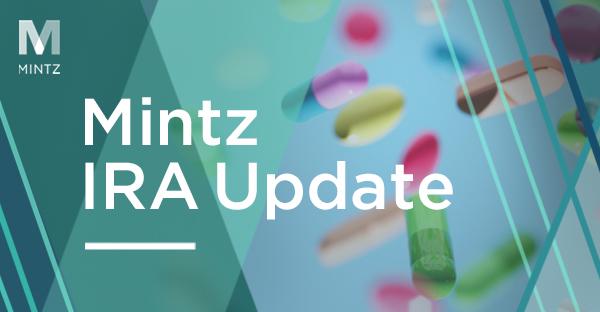A Pivotal Week for Pharmaceutical Policy: Trump Administration Advances Tariff and Drug Pricing Initiatives
The first week of October 2025 marked a significant shift in U.S. drug pricing policy as the Trump administration unveiled a series of sweeping actions to deliver on his promise to lower drug prices. From President Trump’s announcement of a 100% tariff on imported branded drugs to the Trump administration’s landmark pricing deal with Pfizer and the rollout of the TrumpRx.gov direct-to-consumer (DTC) platform, last week marked an escalation in the White House’s efforts to drive down prescription drug costs and bring pharmaceutical manufacturing back to U.S. soil. Below, we provide an overview of the Trump administration’s new policies and the stakeholder responses already reshaping the broader pharmaceutical landscape.
Trump Administration Tariffs on Pharmaceutical Manufacturers
Trump Targets Pharmaceutical Imports with 100% Tariff Plan Tied to U.S. Plant Construction. In April, President Trump issued an Executive Order initiating an investigation into the pharmaceutical supply chain under Section 232 of the Trade Expansion Act of 1962 (Section 232 Executive Order). Pursuant to the Section 232 Executive Order, the Department of Commerce has been investigating the impact of certain pharmaceutical imports as part of a plan to impose tariffs on drugs made outside the U.S. On September 25, 2025, via a post on Truth Social, President Trump announced that beginning October 1, pharmaceutical manufacturers would face a 100% tariff on all “branded or patented” drugs imported to the U.S. However, Trump indicated that manufacturers could avoid these tariffs by building manufacturing facilities in the U.S., defining “building” as either “breaking ground” or “under construction.”
Notably, several key exemptions are likely to limit the impact of the proposed tariffs. In addition to exempting drug companies that are building manufacturing plants in America, the proposed tariffs would not apply to generic drugs. Additionally, a White House official confirmed that the Trump Administration will honor existing trade agreements, including recent EU and Japanese compacts that limit pharmaceutical tariffs to 15%. While the White House has not specified which companies would be affected or what authority would be used to levy the 100% tariff, the threat of tariff exposure appears to be a strategic tool employed by the Trump administration to strike deals with pharmaceutical companies to lower drug prices in the U.S.
Negotiations with Pharmaceutical Manufacturers Continue after Trump Misses Tariff Deadline. On the October 1st tariff deadline, the Trump administration announced the tariffs had not gone into effect and that the administration had now “begun preparing” tariffs on manufacturers that don’t build in the U.S. or enter into a most-favored-nation (MFN) drug pricing agreement with the Trump administration, casting uncertainty over the future of the proposed 100% pharmaceutical tariffs. Following the announcement of Trump’s drug pricing deal with Pfizer (discussed below), Commerce Secretary Howard Lutnick stated the administration intends to let negotiations with other pharmaceutical companies “play out” before imposing any of the proposed pharmaceutical tariffs and is interested in pursuing similar agreements to the Pfizer deal with other pharmaceutical manufacturers. The Pfizer deal suggests the Trump administration has a broader strategy: offering pharmaceutical manufacturers an avenue to avoid the tariffs by voluntarily agreeing to sell drugs at reduced prices.
Trump Strikes Drug Pricing Deal with Pfizer and Announces TrumpRx.Org. As we previously reported, on May 12, 2025, President Trump issued his “Delivering Most-Favored Nation Prescription Drug Pricing to American Patients” Executive Order (MFN Drug Pricing Executive Order). The MFN Drug Pricing Executive Order sought to reduce the price of drugs by requiring manufacturers to offer the United States MFN pricing, or in other words, the lowest price offered to any “comparably developed” foreign country that pays for the same drugs. After months of negotiations between the Trump administration and manufacturers, Pfizer was the first manufacturer to step up to the plate and strike a deal. On September 30, 2025, President Trump announced a landmark agreement with Pfizer to secure several drug pricing concessions. Pfizer has agreed to offer its portfolio of drugs at MFN prices, equal to the lowest prices it offers other developed countries, to every state Medicaid program. Pfizer also agreed to launch new drugs in the U.S. market at the same prices it offers to other developed countries and offer some of its medications directly to consumers at a discounted cash price. In exchange, Pfizer will be exempt from the 100% tariffs described above for three years. Pfizer also committed to channeling $70 billion into research and development while expanding domestic manufacturing in the U.S.
President Trump also announced the 2026 launch of TrumpRx.gov, a Federal DTC prescription drug purchasing platform that will give American patients direct access to discounted drugs. Primary care treatments and select specialty brands will be offered at an average discount of 50%, with some products marked down by as much as 85%.
Manufacturer Response to Trump Administration Executive Orders
Manufacturers Have Announced Investments in U.S. Manufacturing and Production. In response to Trump’s drug pricing executive orders, several global pharmaceutical manufacturers are investing in U.S. manufacturing and production. According to a White House article, Gilead Sciences, Johnson & Johnson, Roche, Novartis, and Bristol Myers Squibb have announced multibillion-dollar investments to expand their domestic footprint in manufacturing, research, and development. Merck, Novo Nordisk, and Eli Lilly have continued to expand their efforts since starting to build in 2023, creating construction sites in Delaware, North Carolina, and Texas with the aim of anchoring U.S.-based supply chains and supporting production of blockbuster medicines. Additionally, Novartis, AbbVie, Amgen, Regeneron Pharmaceuticals, and Abbott Laboratories have announced plans to expand their US-based manufacturing and facilities.
Manufacturers & PhRMA Offering DTC Platforms. As we previously discussed in our last edition of the IRA Update, manufacturers are harnessing President Trump’s directive to adopt DTC purchasing programs. Since the date of our last publication, AstraZeneca, Boehringer Ingelheim, Amgen, and Novartis have joined the list of manufacturers that have implemented DTC programs with steep discounts on their products. In addition to manufacturers, the Pharmaceutical Research and Manufacturers of America (PhRMA) announced plans to launch a new DTC website in January 2026 to allow patients to buy prescription drugs directly from manufacturers, bypassing pharmacy benefit managers and other middlemen. The website, to be called America’s Medicines, will allow manufacturers to list medicines available for direct purchase and connect patients with manufacturers’ DTC programs that offer lower prices and fewer barriers to access. The website will also include a “Medicine Assistance Tool” where patients can search for manufacturers’ patient assistance programs for certain medications.
Drug Companies Have Started Adjusting Their U.S. and European Pricing. In response to Trump’s MFN Drug Pricing Executive Order, some pharmaceutical manufacturers have raised the price of their drugs abroad. Bristol Myers Squibb and AbbVie have announced plans to charge the same price for medicines in the U.K. and the U.S. The Trump administration is asking that manufacturers set medicines at the lowest price in an Organization for Economic Co-operation and Development (OECD) country with a GDP per capita of at least 60% of the U.S. GDP per capita. Since U.K. drug prices tend to be particularly low, the pressure is on pharmaceutical manufacturers to both raise U.K. prices and reduce them in the U.S.
Impact of This Week’s Developments on PBMs, Payors, and Consumers
Impact of Tariffs. If President Trump does follow through on effectuating his 100% tariffs, the impact of the tariff may not be as significant as it appears. For starters, the vast majority of drugs utilized by US patients are generic drugs, which will not be subject to these tariffs. Additionally, most brand-name drug manufacturers already maintain U.S. operations, facilities, and drug distribution models. These factors suggest that many pharmaceutical products would avoid exposure to the proposed tariffs if implemented. The question of whether U.S. patients will see drug price increases will depend on how many drugmakers receive exemptions — and on whether manufacturers choose to pass those costs on to payors or patients. Notably, such price increases would be antithetical to manufacturers’ existing negotiations with the Trump administration and would likely put them even more firmly in the crosshairs of the administration. Payors and PBMs will need to monitor tariff developments to determine if manufacturers intend to reduce or eliminate rebates or related discounts to offset the impact of the tariffs.
Impact of DTC Platforms. Manufacturers have long claimed that the complex pharmaceutical supply chain contributes to the high cost of drugs in the U.S. and thus point to the DTC platforms as a way to lower drug prices. However, the DTC discounts offered by manufacturers may not be lower than the prices patients pay for the drugs through their health insurance. Further, by purchasing drugs directly from manufacturers, patient drug spending will not contribute to their deductibles or out-of-pocket maximums, thus limiting the effectiveness of the mechanisms used to limit patient drug costs over their plan year. The DTC sales platforms may alleviate costs for uninsured patients and patients looking to access drugs not covered by their health insurance.
Medicare Drug Price Negotiation Program Releases Final Guidance for Year 2028
CMS Issues Final Guidance on 3rd Cycle of IRA Drug Price Negotiation Program. On September 30, 2025, the Centers for Medicare and Medicaid Services (CMS) issued its final guidance (Final Guidance) on the third cycle of negotiations, and first cycle of renegotiations, under the IRA’s Medicare Drug Price Negotiation Program (Negotiation Program). As we discussed in our most recent edition of the IRA Update, this Final Guidance is particularly significant as it sets forth CMS’s initial policies for negotiating drugs payable under Medicare Part B and renegotiating previously selected drugs from prior cycles. The Final Guidance also provides further detail on how otherwise eligible drugs can be excluded from the Negotiation Program (e.g., through the small biotech exemption and biosimilar delay provision)—and notably, expands protection for orphan drugs through the orphan drug exclusion in accordance with the “Working Families Tax Cuts Act,” previously known as the “One Big Beautiful Bill Act.” Additionally, the Final Guidance, among other things, refines maximum fair prices (MFP) effectuation policies to further detail what information CMS will use when determining whether a manufacturer has appropriately made available the MFP to a dispensing entity and provides further detail on the selection and negotiation processes to increase transparency in the Negotiation Program. One notable difference between the draft guidance issued in May 2025 and the Final Guidance is that CMS has delayed by one year its efforts to implement a policy that would plug a loophole in the Negotiation Program that allows drugmakers to delay or avoid eligibility for Medicare price negotiation by combining ingredients. We will provide a more in-depth analysis of the Final Guidance in the next edition of the Mintz IRA Update.
We will continue to monitor drug pricing policy and the Trump administration’s efforts to address prescription costs and will provide updates in the next edition of the Mintz IRA Update.
Authors
Theresa C. Carnegie
Member
Stephnie A. John
Associate
Hassan Shaikh
Associate
Attiya S. Khan
Associate

Grace Callander







